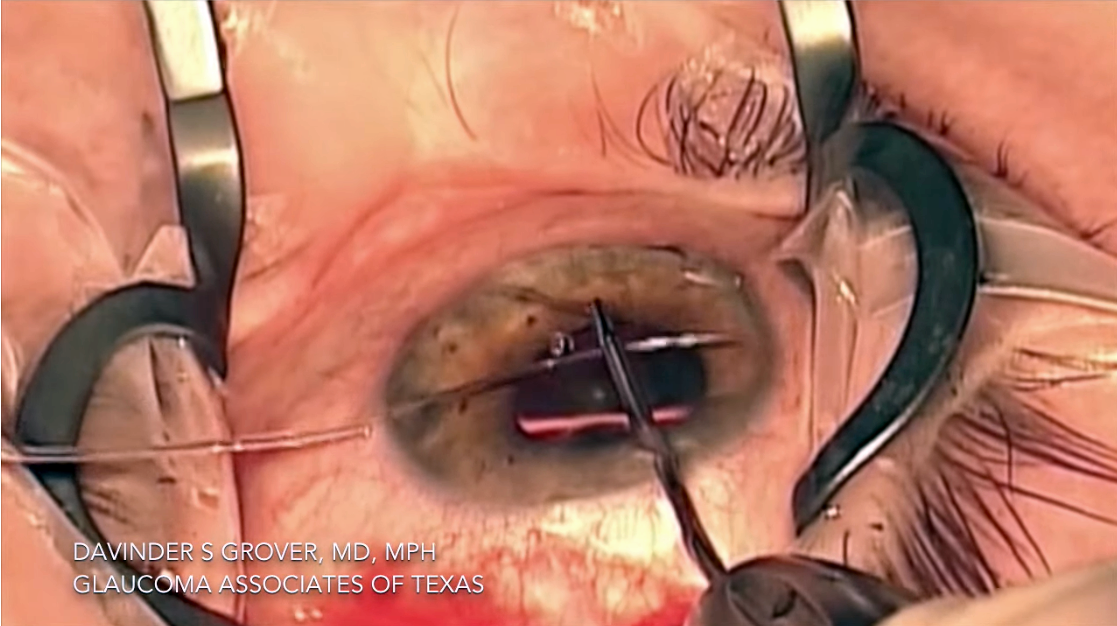 |
|
Disease stage was not a factor in the IOP-lowering efficacy of GATT in this study, as patients mild, moderate and advanced glaucoma all benefited. Photo: Davinder Grover, MD/Glaucoma Associates of Texas. Click image to enlarge. |
Although gonioscopy-assisted transluminal trabeculectomy (GATT) was introduced a decade ago, there’s a lack of research about its efficacy at varying levels of disease. A new study published in American Journal of Ophthalmology aims to close that gap of knowledge.
The foundation of glaucoma treatment is the reduction of intraocular pressure primarily (IOP) through clinical therapies such as topical medications and/or laser therapy, and surgery is usually reserved for patients who don’t respond to first-line treatments or who have risk of side effects. GATT, which improves the aqueous humor flow by tearing the trabecular meshwork and the inner wall of the Schlemm’s canal internally with a microcatheter or a polypropylene suture, has shown success and safety in treating open-angled as well as refractory glaucoma. However, more information is needed about GATT’s application in all levels of glaucoma severity.
A total of 270 eyes were included in this retrospective, multicenter comparative study: 90 in the mild group; 75 in the moderate group; and 105 in the advanced group. Patients underwent GATT (combined with cataract surgery) or GATT standalone. The IOP was reduced from 18.6 Hg to 11.9mm Hg in the mild group, from 19.7mm Hg to 11.8mm Hg in the moderate group and from 21.0mm Hg to 11.9mm Hg in the advanced group at 12 months postoperatively.
The number of glaucoma medications used was reduced from 2.7 to 0.6 in mild, 3.1 to 1.0 in moderate and 3.2 to 1.2 in advanced cases at the last postoperative visit. No serious adverse events were reported in any group.
The authors wrote that one important finding here is that “the IOP was significantly reduced since the first postoperative visit in all groups, and remained linear and with few fluctuations (as shown by small standard deviations) throughout the whole study. These results are very important, since two important issues (especially in advanced glaucoma) were satisfied: low target IOP with small long-term fluctuation.”
Despite the limitations of the retrospective study design—including the fact that data collection wasn’t masked to the disease severity, and the choice for GATT was determined by the surgeon, not randomized—an advantage of the study is its large cohort. “Furthermore, a homogenous cohort was analyzed since only POAG patients were included, and a defined follow-up time (12 months) was chosen, rather than a minimal one; to evaluate all patients approximately at the same time after surgery and not by means of an average follow-up that could allow comparison of patients at very different stages after surgery, a hypothetical important inclusion bias,” stated the authors.
This is the first paper to look into details of GATT results according to preoperative glaucoma severity, wrote the authors. “Despite previous publications indicating good results with GATT even in moderate and advanced glaucoma, it is very important to better understand every surgery behavior (and possible differences) in all stages of glaucoma. Overall, the results presented here demonstrate that GATT is an effective and safe option for glaucoma—regardless of its severity,” they explained in their paper.
“Apparently, the glaucoma severity is not a major variable associated to surgical success, and GATT can be safely and effectively performed in glaucoma; regardless of its preoperative severity,” they concluded. “However, there might be different features related to the procedure’s success other than diagnosis, time of the disease or glaucoma severity such as preoperative IOP, for example. Prospective trials are needed to better answer this important question.”
Magacho L, Vilela de S. Franco CG, et al. Gonioscopy-assisted transluminal trabeculotomy outcomes under different levels of glaucoma severity: a multicenter, comparative study. American Journal of Ophthalmology. February 22, 2024. [Epub ahead of print]. |


